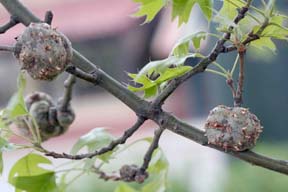Horned Oak Gall | |
|---|---|
| April 15, 2008 | |
|
Horned oak gall has been very common during the past few years from southern into central Illinois, particularly on pin oaks. The galls appear as brown, woody masses up to 2 inches in diameter, covered with "horns" that are 1/8 to 1/4 inch long. By this time of year, many of these horns will have broken off of the galls. The insects that cause these galls are susceptible to control at host bud break.
The horned oak gallmaker is a tiny wasp, Callirhytis cornigera. The adult female wasps emerge from mature twig galls through the horns at bud break to lay eggs on oak leaf veins. Their larvae live inside blisterlike galls on the leaves of oak, emerging as adult male and female wasps in early summer. After mating, females lay eggs in young twigs, where the characteristic twig galls are formed. Full-sized galls take 2 years or more to fully develop. Not only are the galls obvious and objectionable to many people, they commonly kill the twigs past the gall's location. On heavily infested young trees, this is likely to result in distorted branching patterns. The weight of the galls on heavily infested trees can cause the branches to droop and even break. However, it is common to find even heavily infested trees that are apparently healthy, with little branch breakage. It is recommended that galls be pruned off young trees and destroyed to reduce the number of future galls and their impact on the shape of the mature tree. This can be continued as long as the tree is small enough to reach the galls from a step ladder. However, the gallmaker is a native insect that can be very common in natural oak stands. Pruning landscape trees with heavily infested trees nearby is unlikely to have much effect on gall populations, so it is not recommended in those situations. Research indicates that control can also be achieved with an application of bifenthrin, sold as Onyx and Talstar, at bud break. It is likely that other pyrethroid insecticides will also be effective. Realize that with a life cycle of 2 years or longer, it will be a year or more before one can determine the effectiveness of insecticide application. If you attempt insecticidal control of this pest, let us know of your results. | |
| Author: | Phil Nixon |

